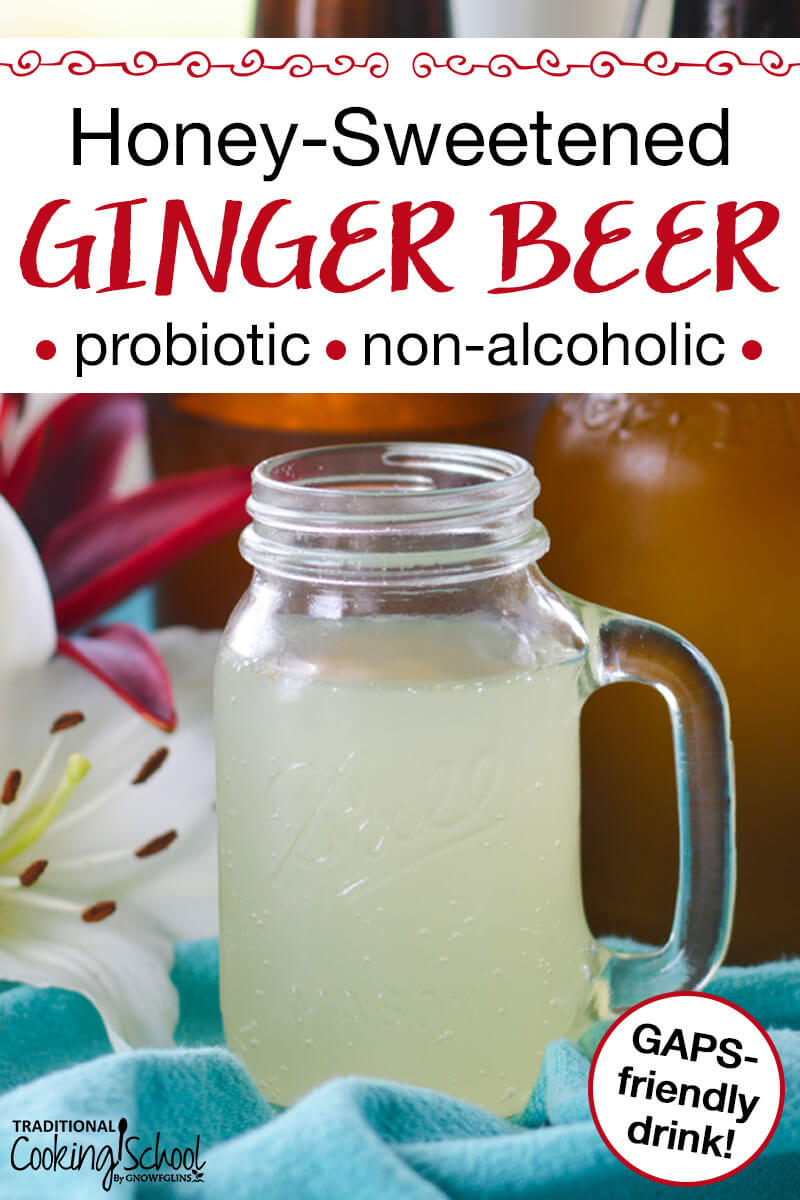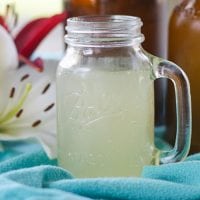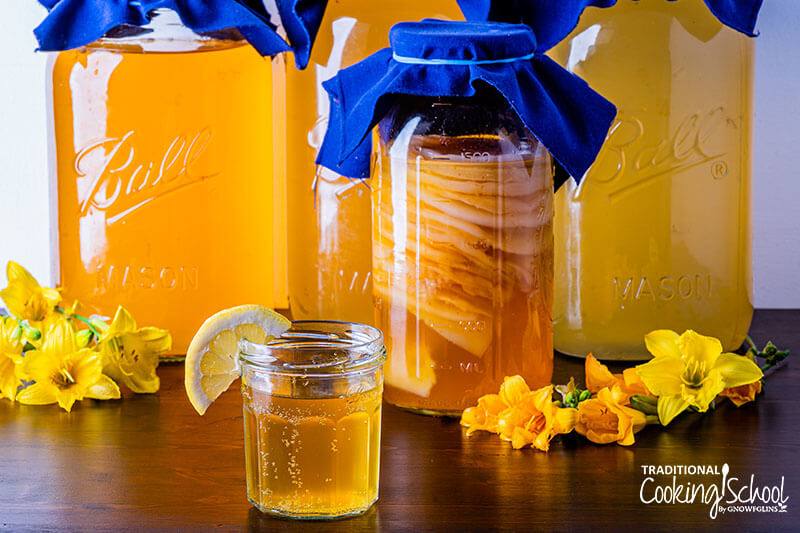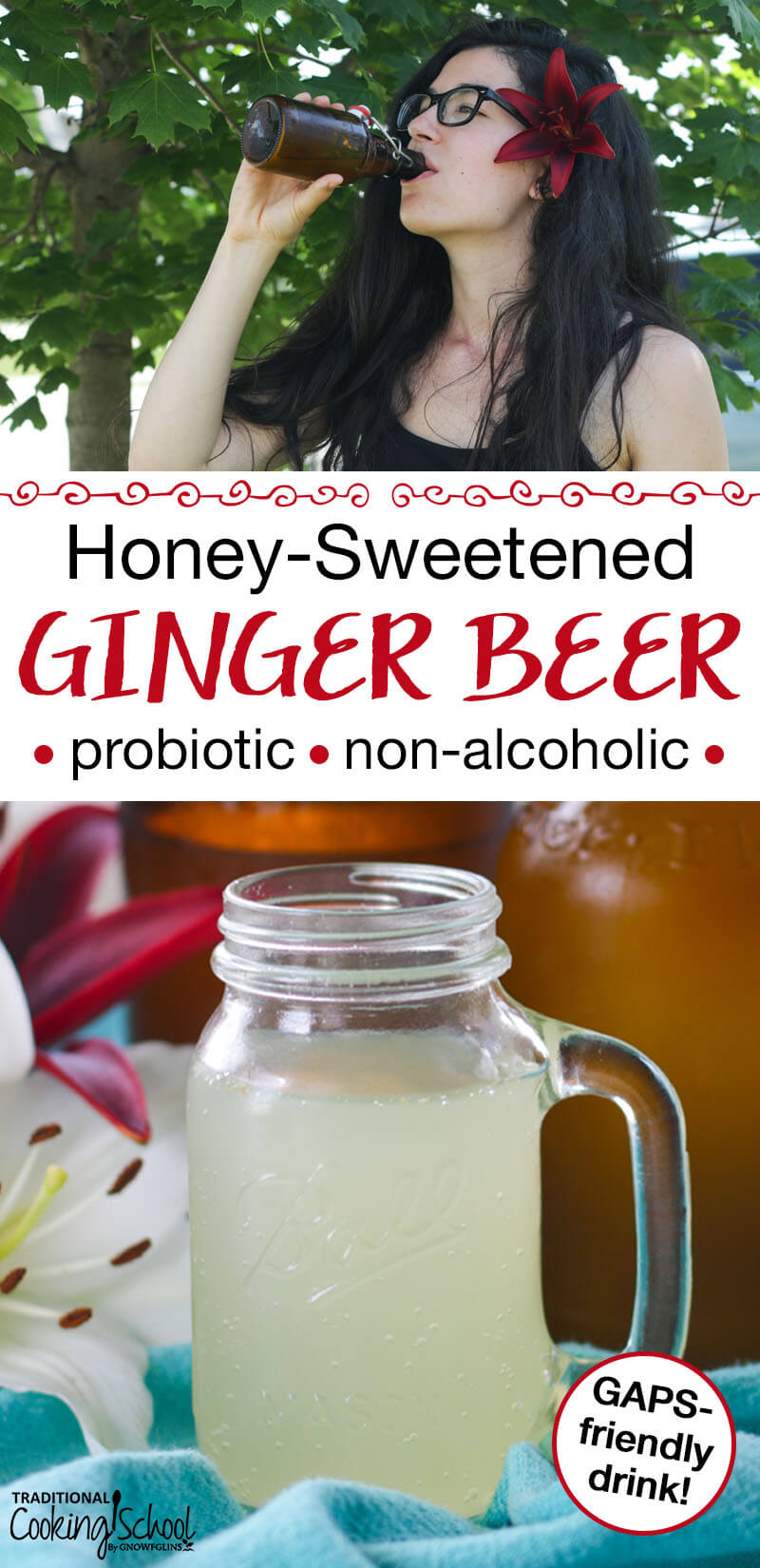
Fermentation transforms sweet ginger water into effervescent ginger beer. Mmmm!
There’s only one problem…
Honey, my sweetener of choice, is anti-bacterial. And if you’re at all familiar with the process of lacto-fermentation, you’ll know that (good) bacteria are essential.
Lacto-fermentation occurs when beneficial bacteria and yeasts eat the sugar in a food and transform it into lactic acid. As they do this, the bacteria and yeasts also respirate (give off gases) and multiply.
In this case, honey feeds the bacteria because it has sugars like glucose and fructose. Yet, honey itself is also anti-bacterial — in other words, it kills bacteria.
So, wait, how are honey-sweetened natural sodas like this ginger beer, Kombucha, and Jun possible?
I’ll let you in on a secret… The key is dilution — and it unlocks a world full of bubbly, pizzazz-y, refined sugar-free beverages such as this honey-sweetened ginger beer!
Why Use Honey?
Some fermentation recipes call for granulated cane sugar (Rapadura, Sucanat, evaporated cane juice, white sugar, etc.) as the sweetener. So why use honey, if you have to worry about dilution?
Honey is a GAPS-friendly sweetener, so families following the GAPS Diet can eat honey-sweetened ferments.
Also, while most of the cane sugar is consumed during fermentation, some remains. For those with a sugar sensitivity, honey provides a way to enjoy natural fermented sodas!
What Equipment Do You Need?
Chances are, you already have everything you need!
- quart Mason jar
- gallon Mason jar
- cheesecloth (or lightweight towel)
- rubber band
- heavy towels (for insulation if your room temperature is cool)
- glass swing-top Grolsch-style bottles (or pint Mason jars with metal lids)*
*These glass Grolsch bottles are airtight so you can store ginger beer in the refrigerator for months without it losing carbonation. You can buy them online, or I’ve found them at thrift stores!
The next best thing to Grolsch bottles are Mason jars with brand-new seals. It doesn’t matter if the ring is new or not, but the seal needs to have plenty of wax on it to keep air out. Mason jars won’t build up carbonation as well as Grolsch bottles, but the ginger beer will still be delicious.

Honey-Sweetened Ginger Beer {probiotic, non-alcoholic, GAPS-friendly natural soda!}
This Honey-Sweetened Ginger Beer is a probiotic, non-alcoholic, GAPS-friendly natural soda. And yes, it's a ferment sweetened with honey! Learn how this is possible so you can make this bubbly, pizzazz-y, traditionally fermented drink!
Ingredients
- 2-3 medium-sized ginger roots fresh, many grocery stores have old, dry roots, so try a health food store if this is the case
- pure water
- 1/3 cup lemon juice
- 3/4 cup raw honey + more
Instructions
-
There are three stages to making homemade soda: 1) make the starter a.k.a. ginger bug, 2) make the wort, and 3) bottling.
Stage 1: Make The Ginger Bug
-
Fill a quart-size jar with water about two-thirds full.
-
Wash (but don’t peel) and grate the ginger.
-
Add 1 tablespoon grated ginger to jar of water.
-
Add 1 tablespoon honey.
-
Stir well to dissolve the honey and to incorporate lots of air. This ferment is aerobic and requires air.
-
Cap the jar with a cheesecloth and rubber band (or sprout screen and metal band).
-
Leave in a warm place to ferment (between 75 and 85 degrees Fahrenheit is best). Cover or insulate the jar with towels if it is a cooler time of year. You can also keep the starter on a seedling warming mat.
-
Every 12 hours (morning and night), stir and taste your starter. Does it need another feeding? Is it too sweet? Is it too strong? You want to keep the mixture mildly gingery and slightly sweet.
-
Depending on how it tastes, either hold off on feeding it or feed it about 1 tablespoon of grated ginger + 1 tablespoon honey + 2 tablespoons water (to keep the honey diluted). You may need to feed it every 24 hours or every couple of days.
-
It takes anywhere from 3 to 7 days to get a strong ginger bug. The length of time depends on temperature, stirring, and honey content.
-
It is ready when you see a layer of bubbles on the top of the starter, and it fizzes when you stir it. This is the carbonation releasing.
-
If you ever notice that bubbles were forming but have since stopped, simply dilute the starter with more water.
Stage 2: Make The Ginger Wort
-
Add 1 cup ginger bug, 1/3 cup well-packed grated ginger root (plus more if desired), 1/3 cup lemon juice, and 3/4 cup honey to a gallon jar.
-
Fill to the shoulder with water. This is now called the "wort" (soda before fermentation).
-
Stir wort well to incorporate lots of air, and to dissolve the honey.
-
Taste. It should be sweet and gingery, but not too strong.
-
Cover with cheesecloth and rubber band. Allow to sit in a warm location, cover with towels, or keep on a seedling warming mat if the temperature is cooler.
-
Stir every 12 hours (morning and night) for 3 to 7 days, tasting as you go. Add more honey if it loses all sweetness, but not too much because you want only a slightly sweet ginger beer.
-
The wort is ready for bottling when there is a layer of bubbles on top, and it fizzes when you stir it.
-
If you're not seeing any bubbles and your room temperature has been warm, add another cup of starter. Stir well. Give it another day or two for bubbles and fizz to form.
Stage 3: Bottle The Ginger Beer
-
Taste the wort and add any additional flavors such as dried fruit, preserves, overripe fruit, etc.
-
Use a funnel with a strainer to fill swing-top Grolsch bottles or pint Mason jars to within 1-1/2 to 2 inches of the top. This will ensure that no bottles break as the carbonation builds up.
-
Cap or cover the bottles or jars. Set aside in the same warm location where you fermented the bug and wort.
-
Leave for 3 to 7 days, depending on the temperature.
-
Open and test for done-ness on about day 3. If it fizzes, it's done! If not, cap and allow to sit for another 24 hours, then check again.
-
Keep checking every day until the ginger beer is carbonated to your preference. The longer it sits, the less sweet it becomes.
-
When done, refrigerate the bottles.
-
Once chilled, enjoy!
Recipe Notes
- Makes 1 gallon.
- What to do with leftover starter? After you make your wort, there will be leftover ginger bug. Keep feeding it (ginger + honey + water) for future batches of ginger beer. Or, if you don't plan on making any other batches of soda soon, add it all to the wort in one batch.
- Keep a close eye on your fruit-flavored sodas! Sealed carbonated things can blow up, especially fruit-flavored sodas. Cut their fermentation time in half, and watch them closely once capped. Open these bottles outside when checking for done-ness. Once done, refrigerate immediately.

Other Fermented Beverages
- How To Make Kombucha (pictured above)
- The ULTIMATE Kombucha Guide
- The ULTIMATE Water Kefir Guide
- 50+ Probiotic & Fermented Drinks Beyond Kombucha & Kefir!
- Is Jun Right For You? All Your Questions Answered!
- How To Make Beet Kvass
- Spontaneously Fermented Sparkling Apple Cider
- 5-Minute Probiotic Mixed Berry Switchel {Paleo, GAPS, AIP}
What is your favorite natural soda for summer?
We only recommend products and services we wholeheartedly endorse. This post may contain special links through which we earn a small commission if you make a purchase (though your price is the same).



Wow, Haniya!! This honey-sweetened version of ginger beer is much-longed for by so many in the healing and wellness diets community!! A dream come true! How exciting!! Pinning!
Thank you so much, Megan! <3 It's SUCH a fun recipe -- I've loved making it and drinking it!
Congratulations on finding the way to make it with honey instead of sugar!! I’m going to give it a try!!
Thanks Heather! Hope you love it as much as we do! 🙂
I’m so excited to try your recipes. I just listened to the book “Brain Maker,” and I’m looking for a cheaper beverage than GF Beer. I’m also looking to use honey instead of sugar always.
Hey! So I am trying my hand at this recipe even though I’ve never made anything like this before! I have made the ginger bug and am in the wort stage (almost been 1 week) and it fizzes a lot, but there isn’t a layer of bubbles at the top. I can hear it fizzing whenever I go near and it fizzes when I stir it too. Unfortunately, I didn’t read far enough in your recipe and already used up all of the ginger bug so I don’t have the option of adding more starter… what would you recommend I do? Is it ok to add to the bottles or do I need the layer in order to do that step?
Hi Jessica! I’m not sure why there aren’t any bubbles, but fizz is a great sign. I would say — go ahead and bottle it. If it’s fizzing so much it should still build up carbonation in the bottles and turn out deliciously! Let me know how it goes for you. 🙂
Thanks, Haniya, for your reply! I just bottled it up so hopefully it will turn out ok! One last quick question. It does smell fermented… how do I know that it won’t be alcoholic? (clearly I’m a newbie here, so thanks for understanding!)
Hi! No problem on the question — it’s a good one. 🙂 As with any naturally fermented beverage, it’s the yeast that creates the alcohol as a byproduct of the carbonation process. So the longer it ferments, and the more fizzy/bubbly it gets, the more alcohol produced. HOWEVER, it’s very minimal alcohol which is why ginger beer is usually classed as “non-alcoholic”. To reduce alcohol, you can reduce fermentation time and just deal with less fizziness (and more sweetness).
Also, this may not be completely relevant, but when making water kefir (a.k.a. kefir soda) the alcohol is produced only during the bottling stage of fermentation (source: https://kellythekitchenkop.com/does-kefir-soda-have-alcohol/ ). So it doesn’t matter how long the drink was fermented prior to that. If that holds true for ginger beer as well, you can reduce bottling time to limit alcohol, and continue on with the rest of fermentation as normal.
Does this help? 🙂
Thanks so much!! I really appreciate you getting back to me, and so quickly! I bottled it up and it sure has a lot of pressure when I opened it. It opened with a pop and sprayed all over (thankfully, I was outside)! It definitely has a strong beer taste… is that normal?
You’re welcome! 🙂 Hmmm… are you sure it’s a beer taste and not a normal sour fermented flavor? If it does taste like beer, you can certainly still drink it if you’d like, but I wonder if maybe what was true for water kefir (that alcohol is produced only during bottling) doesn’t hold for ginger beer. If that’s the case, then perhaps you need to reduce fermenting time for the ginger wort. If you bottled it after about a week, maybe you need to bottle the wort around 3 days instead, as long as it’s fizzy at that point. Let me know what you try 🙂
My first ever batch of ginger beer I didn’t ferment as long (in the wort stage) and it turned out fairly sweet, yet still bubbly and delicious after bottling. My second batch, I left longer during the wort stage (because I didn’t have bottles free yet), and it acquired a slight “beer” smell but I went ahead with bottling anyway and it turned out fine. Less sweet then the first batch but it didn’t taste like beer, just sour and fermented. So I think maybe a shorter wort fermentation stage is the answer!
That makes a lot of sense! I left mine in the wort stage for 1 week because I was unsure since it didn’t have that layer of bubbles at the top, even though it was actively fizzing… next time I will try leaving it for a shorter period of time!
Great! I would love to hear how it goes! 🙂
Thanks Haniya, for a detailed explanation. Your title says non alcoholic. If it fizzes it is from the carbon dioxide produced when yeast consumes glucose and the by product is alcohol and carbon dioxide; as well as from hetero fermentive strains of lactic acid bacteria which in the presence of oxygen choose the pathway of converting glucose into alcohol and carbon dioxide. Since we are stirring every 12 hours we are introducing oxygen which encourages yeast activity and hetero fermentive strains to produce alcohol; as well as introduces wild yeast. So, would you share what percentage of alcohol is in this ginger soda?
Hi Suzi, you are correct that there is a small amount of alcohol produced as a result of carbonation. However, it’s minimal enough that most ginger beer is still termed “nonalcoholic”. I’m sorry that I don’t know the exact percentage of the alcohol to share with you. 🙂
I make ginger beer in a similar way and can get about 5% ABV in a week, you will want to ferment for a shorter time if you don’t want the alcohol.
Revision to my last comment, 3.5% ABV with that much honey.
I am very use to of having beer while eating my dinner which is make me chubby day by day but after reading your article about Honey Sweetened Ginger Beer which has GAPS-friendly natural soda. I seal my solution to solve my problem.
Hi there, just giving the recipe a go and I’m a little confused. I’m doing the first step, making the ginger beer bug. You mentioned checking if it’s too sweet or too strong. Do I feed it off it tastes too sweet or if it doesn’t taste sweet enough?
Just the recipe I’ve been looking for!
This is my first fermentation outside of Spirits, it tastes incredible. Thanks for posting! 🙂
Hi – I’m excited to try this, but
1) for the bottling step will you get additional carbonation without adding something sweet like the fruit you mention? (I’m not familiar with flavored ginger beer and like the taste of plain store-bought ginger beer.)
2) Also, if I try it with fruits, which ones are your favorites and how much for each bottle?
Can’t wait to try this!
I have a jar of turmeric and ginger honey, could I dilute this and try to make a bug? OR do you think the turmeric and ginger will have already fermented too far?
Or, no harm in trying? haha
Is the lemon juice for flavor, or does it serve a purpose in the wort? My mother is fruit intolerant, so I am wondering if I should replace the lemon juice with another acid, or if it is for flavor, I could replace it with a variety of things.
HI Wardee
I love this recipe. I made a batch last year and put it in the fridge. Sadly a couple of bottles were forgotten in the back of the fridge. I opened one today, and it smells wonderful. still fizzy and has no off taste or smell. do you feel it’s safe to drink? I’d hate for it to go to waste after spending all the time making it.
Thank you 🙂
Does the ginger root need to be fresh? While making a cold brew long steeped tea that called for dried grated ginger I got fizz at the top of my jar. Would it be possible to make this tea into a soda?
My ginger bug had bubbles but my wort doesn’t have any bubbles and doesn’t really fix. I added another cup of bug but still don’t have activity. It is on a seedling heating mat
This looks so good! What a great combination of flavors!
Made my 1st quart of Ginger /dried gogi berry bug, I tasted it and couldn’t stop drinking so I have to try another round of ginger bug to make the ginger beer. Hopefully, I can do it. It was beyond tasty?